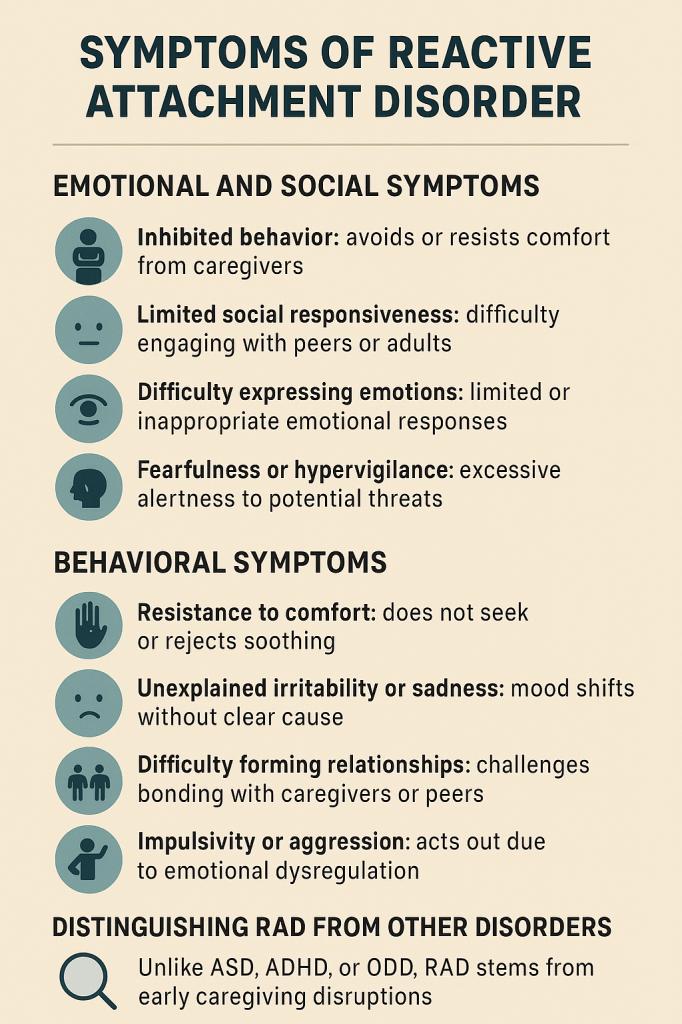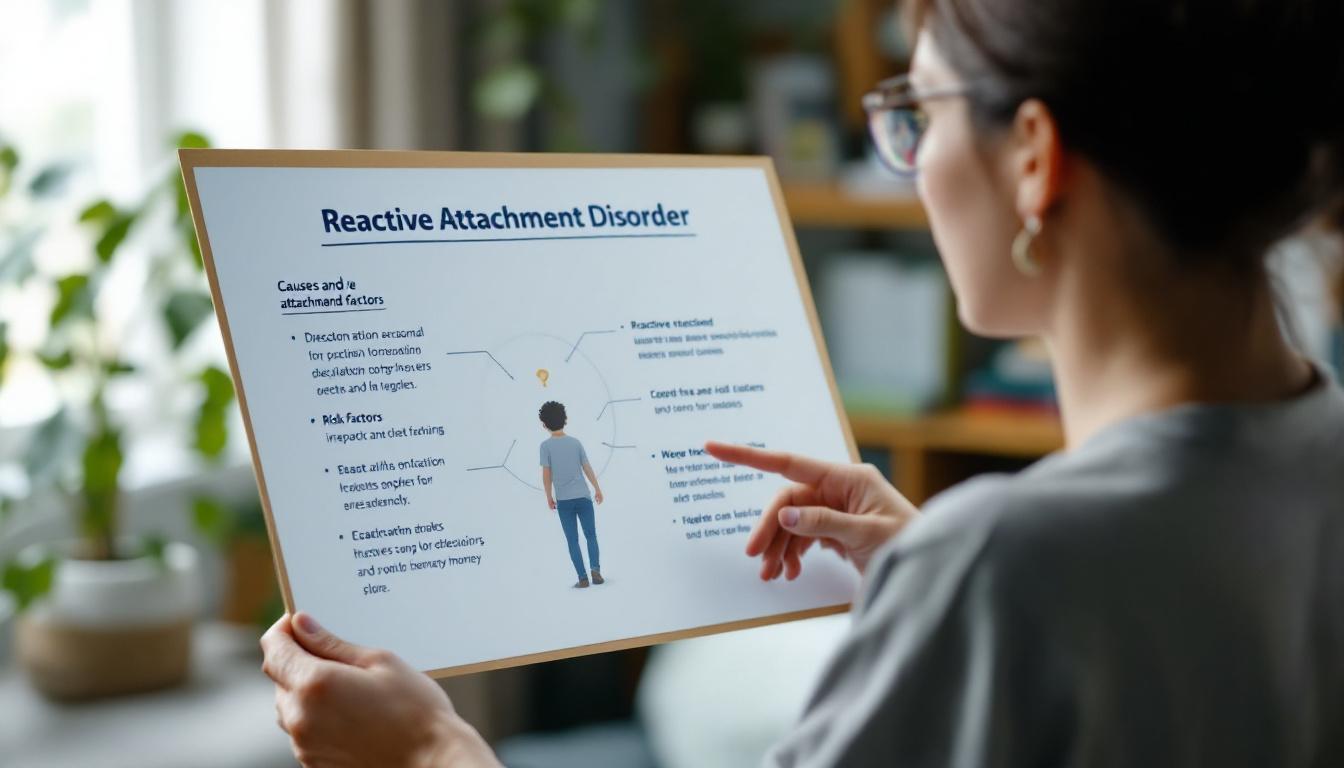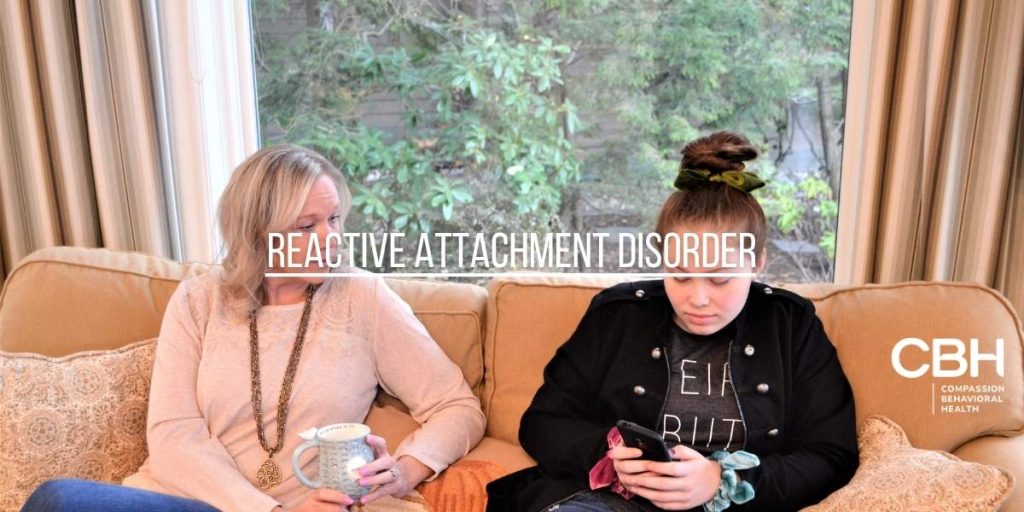Summary
Reactive Attachment Disorder (RAD) is a complex and often misunderstood condition that affects children who have experienced severe disruptions in early caregiving relationships. Characterized by difficulties in forming healthy emotional bonds, RAD can lead to significant challenges in social, emotional, and behavioral development. This article explores the symptoms, causes, and treatment options for RAD, providing a comprehensive overview to help caregivers, educators, and mental health professionals recognize and support affected children effectively.

The roots of RAD often lie in adverse childhood experiences, such as neglect, abuse, or frequent changes in caregivers. These early traumas can hinder a child’s ability to trust and connect with others, resulting in a range of emotional and behavioral issues. Children with RAD may exhibit withdrawal from social interactions, difficulty regulating their emotions, and an inability to seek comfort from caregivers. Understanding the impact of these early experiences is crucial for fostering a supportive environment that encourages healing and attachment.
Moreover, the treatment of RAD typically involves a multi-faceted approach, including therapy, family support, and sometimes medication to address co-occurring conditions like anxiety or depression. Therapeutic interventions such as play therapy and attachment-focused therapy can be particularly beneficial, as they help children express their feelings and learn to build trust in a safe setting. Caregivers play a vital role in this process, as their understanding and responsiveness can significantly influence a child’s ability to form secure attachments and thrive emotionally.
What is Reactive Attachment Disorder?
Reactive Attachment Disorder is a rare but serious condition that arises when a child fails to establish a secure emotional attachment to primary caregivers during early childhood. Attachment is a critical developmental process that influences a child’s ability to form trusting relationships and regulate emotions throughout life. When this process is disrupted, children may develop RAD, which manifests as difficulty in forming healthy attachments and responding appropriately to social interactions.
RAD is classified in the Diagnostic and Statistical Manual of Mental Disorders (DSM-5) under trauma- and stressor-related disorders. It typically emerges before the age of five and is most common in children who have experienced neglect, abuse, frequent changes in caregivers, or institutionalization. The symptoms of RAD can vary significantly, with some children displaying withdrawn behavior while others may exhibit anger and aggression. This variability can make diagnosis challenging, as it requires careful observation and a comprehensive understanding of the child’s history and environment.
Why Early Attachment Matters
Attachment theory, first developed by psychologist John Bowlby, emphasizes the importance of a consistent and nurturing caregiver-child relationship. Secure attachments provide a foundation for emotional security, social competence, and resilience. Without this foundation, children may struggle with trust, empathy, and self-regulation, which are hallmarks of RAD. The absence of a reliable attachment figure can lead to a pervasive sense of insecurity, making it difficult for the child to navigate social situations or express their emotions effectively.
Furthermore, early attachment experiences shape the brain’s development, influencing cognitive functions and emotional responses. Research indicates that children with secure attachments tend to develop better problem-solving skills and are more adept at managing stress. Conversely, those with RAD may find themselves caught in a cycle of emotional dysregulation, which can lead to further behavioral issues and difficulties in school and peer relationships. Understanding the profound impact of early attachment can help caregivers and professionals create supportive environments that foster healing and growth for children affected by RAD.
Symptoms of Reactive Attachment Disorder
Recognizing RAD can be challenging because its symptoms often overlap with other developmental or behavioral disorders. However, certain hallmark signs distinguish RAD from other conditions. Early identification is crucial, as timely intervention can significantly improve outcomes for affected children.

Emotional and Social Symptoms
- Inhibited behavior: Children may avoid or resist comfort and affection from caregivers, appearing withdrawn or emotionally detached. This behavior can stem from a learned belief that seeking help or affection will not be met with a nurturing response.
- Limited social responsiveness: Difficulty engaging with peers or adults in a warm or reciprocal manner. These children may struggle to understand social cues, leading to further isolation and misunderstanding in social situations.
- Difficulty expressing emotions: Children with RAD often have trouble showing a full range of emotions or may display inappropriate emotional responses. They might react to situations with anger or frustration instead of sadness or disappointment, complicating their interactions with others.
- Fearfulness or hypervigilance: A heightened state of alertness to potential threats, often stemming from early trauma. This constant state of readiness can lead to exhaustion and increased anxiety, impacting their overall well-being.
Behavioral Symptoms
- Resistance to comfort: When upset, children may not seek comfort or may reject attempts at soothing. This can be particularly distressing for caregivers who may feel helpless in their attempts to provide support.
- Unexplained irritability or sadness: Mood swings or persistent sadness without clear cause. These emotional fluctuations can create a challenging environment for both the child and their family, often leading to frustration and confusion.
- Difficulty forming relationships: Challenges in bonding with caregivers or peers, leading to social isolation. This difficulty can manifest in avoidance of group activities or reluctance to engage in play, further exacerbating feelings of loneliness.
- Impulsivity or aggression: Some children may exhibit aggressive behaviors as a response to emotional dysregulation. This impulsivity can lead to conflicts with peers and authority figures, making it harder for the child to navigate social norms.
Distinguishing RAD from Other Disorders
It is important to differentiate RAD from other conditions such as Autism Spectrum Disorder (ASD), Attention Deficit Hyperactivity Disorder (ADHD), or Oppositional Defiant Disorder (ODD). Unlike these disorders, RAD specifically relates to attachment issues stemming from early caregiving disruptions. A thorough assessment by a mental health professional is essential for accurate diagnosis. This process often involves gathering comprehensive histories from caregivers and teachers, as well as direct observations of the child’s behavior in various settings. Understanding the nuances of RAD can lead to more effective treatment strategies tailored to the child’s unique needs.
Causes and Risk Factors of Reactive Attachment Disorder
RAD primarily results from severe neglect or maltreatment during critical periods of early development. Understanding these causes helps in prevention and early intervention efforts.

Early Childhood Neglect and Abuse
Children who experience neglect—such as lack of emotional responsiveness, inconsistent caregiving, or physical abandonment—are at high risk for developing RAD. Abuse, including physical, emotional, or sexual abuse, further compounds this risk by creating an environment of fear and mistrust. The impact of such adverse experiences can be profound, leading to difficulties in emotional regulation and social interactions that persist into later life. For instance, children who have been neglected may struggle to form healthy relationships, often viewing others with suspicion or detachment, which can hinder their ability to connect with peers and caregivers alike.
Frequent Changes in Caregivers
Children in foster care or institutional settings often face multiple caregiver changes, which disrupt the formation of stable attachments. Research indicates that children who experience more than three caregiver transitions before age five are significantly more likely to develop attachment difficulties. Each transition not only disrupts the child’s sense of security but also reinforces feelings of abandonment and instability. The emotional toll of such experiences can lead to a cycle of mistrust, where the child becomes increasingly withdrawn or aggressive, further complicating their ability to form lasting bonds with future caregivers.
Institutionalization and Orphanage Care
Studies of children raised in orphanages with limited caregiver interaction reveal higher rates of RAD. The lack of individualized attention and nurturing relationships in these settings impairs attachment development. In many cases, children in these environments may not receive the consistent emotional support necessary for healthy attachment, leading to developmental delays and difficulties in socialization. The stark reality of institutional care often means that children are treated more like a number than as individuals, which can exacerbate feelings of isolation and worthlessness. This lack of personal connection can hinder their ability to trust others and develop a secure sense of self.
Biological and Environmental Factors
While environmental factors are primary, some research suggests that genetic predispositions or prenatal complications may contribute to vulnerability. Additionally, parental mental health issues, substance abuse, or domestic violence can indirectly increase risk by impairing caregiving quality. For example, a parent struggling with untreated depression may be less able to respond to their child’s needs, leading to a cycle of neglect. Furthermore, exposure to toxic stress during pregnancy can affect fetal brain development, potentially predisposing the child to emotional and behavioral difficulties later in life. Understanding these complex interactions between biology and environment is crucial for developing effective interventions and support systems for at-risk families.
Diagnosis and Assessment
Diagnosing RAD requires a comprehensive evaluation by qualified mental health professionals, often including psychologists, psychiatrists, or developmental pediatricians. The process is intricate, as it must take into account the child’s history, environment, and individual circumstances. Professionals often collaborate with teachers and other caregivers to gather a holistic view of the child’s behavior across different contexts.
Clinical Interviews and Observations
Clinicians gather detailed histories from caregivers and observe the child’s interactions in various settings. They assess attachment behaviors, emotional responsiveness, and social engagement patterns. Observations may take place in naturalistic settings, such as at home or in school, allowing clinicians to see how the child interacts with peers and authority figures. This comprehensive approach helps to identify not only the symptoms of RAD but also the underlying causes and contributing factors that may be influencing the child’s behavior.
Use of Standardized Tools
Several assessment tools help identify attachment disorders, including:
- The Disturbances of Attachment Interview (DAI)
- The Attachment Disorder Screening Inventory (ADSI)
- The Child Behavior Checklist (CBCL)
These tools provide structured ways to evaluate symptoms and differentiate RAD from other disorders. They often include questionnaires that assess various aspects of a child’s behavior and emotional state, allowing for a more nuanced understanding of their attachment style. Additionally, these standardized assessments can help in tracking progress over time, providing valuable insights into the effectiveness of interventions and therapies implemented.
Importance of Early Diagnosis
Early identification of RAD is crucial because timely intervention can significantly improve outcomes. Delayed diagnosis often leads to entrenched behavioral problems and difficulties in forming relationships later in life. The earlier a child receives appropriate support, the better their chances of developing healthy attachments and social skills. Furthermore, early intervention can also alleviate the emotional distress experienced by both the child and their family, fostering a more nurturing environment that promotes healing and growth. Parents and caregivers are encouraged to remain vigilant and seek professional help if they notice signs of attachment issues, as proactive measures can lead to positive long-term changes.
Treatment Approaches for Reactive Attachment Disorder
Treating RAD is a multifaceted process that requires patience, consistency, and specialized therapeutic strategies tailored to the child’s needs.
Therapeutic Interventions
- Attachment-Based Therapy: Focuses on building trust and secure attachments between the child and caregiver through guided interactions and emotional support.
- Parent-Child Interaction Therapy (PCIT): Enhances positive communication and strengthens the caregiver-child bond by teaching caregivers effective interaction techniques.
- Trauma-Focused Cognitive Behavioral Therapy (TF-CBT): Addresses trauma-related symptoms and helps children develop coping skills.
Role of Caregivers
Caregivers play a central role in treatment. Consistency, patience, and nurturing responses help create a safe environment where the child can develop trust. Training and support for caregivers are often necessary to equip them with strategies to manage challenging behaviors and foster attachment.
Educational and Social Support
Children with RAD may benefit from specialized educational plans and social skills training. Schools and community programs that provide stable, supportive environments contribute to improved social functioning and self-esteem.
Medication
There is no medication specifically approved for RAD. However, medications may be prescribed to manage co-occurring symptoms such as anxiety, depression, or ADHD under careful medical supervision.
Challenges and Considerations in Managing RAD
Managing RAD requires addressing several challenges that can complicate treatment and recovery.
Complex Trauma and Comorbidities
Many children with RAD have experienced complex trauma, which can lead to additional mental health issues such as Post-Traumatic Stress Disorder (PTSD), anxiety, or depression. Treatment plans must be holistic and flexible to address these overlapping conditions.
Stigma and Misunderstanding
RAD is often misunderstood, leading to stigma for both the child and caregivers. Educating families, schools, and communities about the disorder helps reduce misconceptions and promotes empathy and support.
Long-Term Outlook
With appropriate intervention, many children with RAD can develop healthier attachments and improve their emotional and social functioning. However, untreated RAD may lead to ongoing difficulties in relationships, self-esteem, and emotional regulation into adulthood.
Prevention and Early Intervention
Preventing RAD involves ensuring children receive consistent, nurturing care from birth. Early intervention programs that support at-risk families can reduce the incidence of attachment disorders.
Supporting At-Risk Families
- Providing parenting education and resources.
- Offering mental health support for caregivers.
- Ensuring stable and loving foster or adoptive placements.
Screening and Monitoring
Regular developmental screenings during pediatric visits can help identify early signs of attachment difficulties, enabling prompt referrals for evaluation and support.
Conclusion
Reactive Attachment Disorder is a serious but treatable condition rooted in early disruptions to caregiving relationships. Understanding its symptoms, causes, and treatment options is essential for caregivers, educators, and professionals who support affected children. Through early diagnosis, compassionate care, and evidence-based interventions, children with RAD can build secure attachments and lead healthier, more fulfilling lives.
If you or a loved one is struggling with Reactive Attachment Disorder, remember that you are not alone. At Compassion Behavioral Health, we understand the complexities of mental health and are here to offer a customized approach to treatment. Our team is committed to fostering long-term recovery and helping you achieve your highest physical and mental health. Conveniently located in South Florida, our Hollywood rehab center is a place of hope and healing. Don’t hesitate to Call Us Today and take the first step towards a healthier, more fulfilling life.



